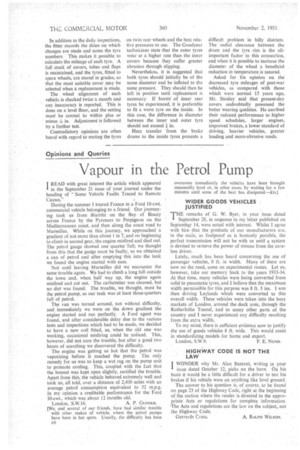Opinions and Queries Vapour in the Petrol Pump I READ
Page 44

If you've noticed an error in this article please click here to report it so we can fix it.
with great interest the article which appeared I in the September 21 issue of your journal under the heading of "Some Vehicle Faults Traced to Remote Causes."
During the summer I toured France in a Ford 10-cwt. commercial vehicle belonging to a friend. Our journeying took us from .Biarritz on the Bay. of Biscay across France by the Pyrenees to Perpignon on the Mediterranean coast, and then along the coast road to Marseilles. While on this journey, we approached a gradient of not more than about 1 in 7, and on beginning to climb in second gear, the engine misfired and died out. The petrol gauge showed one quarter lull; we thought from this that the gauge must be faulty, so we obtained a can of petrol and after emptying this into the tank we found the engine started with ease.
Not until leaving Marseilles did we encounter the same trouble again. We had to climb a long hill outside the town and, when half way up, the engine again misfired and cut out. The carburetter was cleaned, but no dirt was found. The trouble, we thought, must be the petrol pump, as our tank was at least three-quarters full of petrol.
The van was turned around, not without difficulty, and immediately we were on the down gradient the engine started and ran perfectly. A Ford agent was found, and after considerable delay due to the various tests and inspections which had to be made, we decided to have a new coil fitted, as, when the old one was working, occasional misfiring could be noticed. This, however, did not cure the trouble, but after a good two hours of searching we discovered the difficulty.
The engine was getting so hot that the petrol was vaporizing before it reached the pump. The only remedy for us was to keep a wet rag on the pump unit to promote cooling. This, coupled with the fact that the bonnet was kept open slightly, rectified the trouble. Apart from this, the vehicle behaved extremely well and took us, all told, over a distance of 2,400 miles with an average petrol consumption equivalent to 32 m.p.g. In my opinion a creditable performance for the Ford 10-cwt., which was about 12 months old.
London, S.W.16. A. P. GUNNER.
[We, and several of our friends, have had similar trouble with other makes of vehicle, where the petrol pumps have been in hot spots. Usually, the difficulty has been c6
overcome immediately the vehicles have been brought reasonably level or, in other cases, by waiting for a few minutes until some of the heat has dissipated.---ED.1
WIDER GOODS VEHICLES . JUSTIFIED THE remarks of G. W. Byer, in your issue dated September 28, in response to my letter published on September 14, were noted with interest. Whilst I agree with him that the products of our manufacturers arc, in the main, as foolproof as is humanly possible, the perfect transmission will not be with us until a system is devised to remove the power of misuse from the careless driver.
Lately, much has been heard concerning the use of passenger vehicles, 8 ft. in width. Many of these are now on the road, sonic on experimental routes. Let us, however, take our memory back to the years 1933-34. At that time, many vehicles were being converted from solid to pneumatic tyres, and I believe that the maximum width permissible for this purpose was 8 ft. 3 ins. I was then driving Leylands which were converted to this overall width. These vehicles were taken into the busy markets of London, around the dock area, through the Rotherhithe Tunnel, and to many other parts of the country and I never experienced any difficulty resulting from the extra width.
To my mind, there is sufficient evidence now to justify the use of goods vehicles 8 ft. wide. This would assist in standardizing models for home and export.
London, S.W.9. F. E. Nuraa.
. HIGHWAY CODE IS NOT THE LAW
WONDER. why Mr. Alan Bezzant, writing in your I issue dated October 12, picks on the horn. On his basis it would be a little difficult for a driver to test his brakes if his vehicle were on anything like level ground.
The answer to his question is, of course, to be found on page 23 of the Highway Code, right at the beginning of the section where the reader is directed to the appropriate Acts or regulations for complete information. The Acts and regulations are the law on the subject, not the Highway Code.
Gerrards Cross. A. RALPH WILSON.




























































































